Alice in Wonderland (1951 film)
7.8 /10 2 Votes
79% Rotten Tomatoes Genre Animation, Adventure, Family Country United States | 7.4/10 IMDb Duration Language English | |||||||||||||||||||||||||||||||||
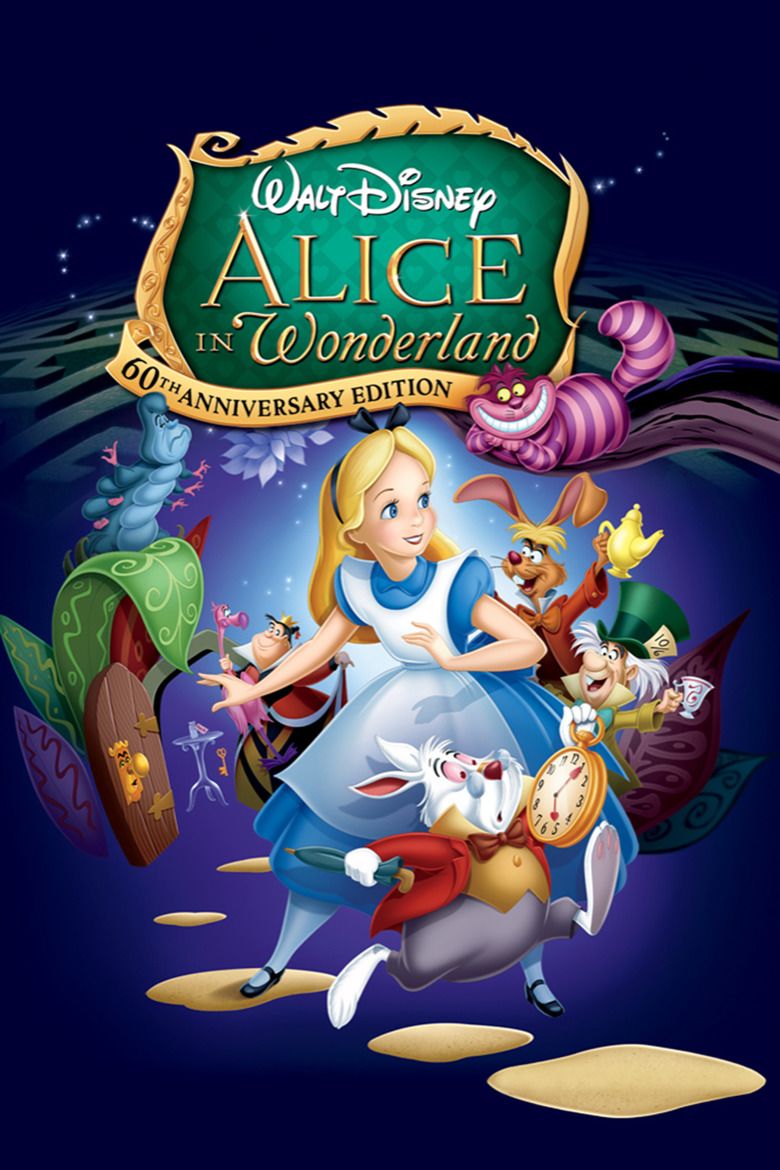 | ||||||||||||||||||||||||||||||||||
Director Clyde GeronimiWilfred JacksonHamilton Luske Writer Lewis Carroll (adaptation), Winston Hibler (story), Ted Sears (story), Bill Peet (story), Erdman Penner (story), Joe Rinaldi (story), Milt Banta (story), William Cottrell (story), Dick Kelsey (story), Joe Grant (story), Dick Huemer (story), Del Connell (story), Tom Oreb (story), John Walbridge (story) Initial release July 26, 1951 (United Kingdom) Songs Alice in Wonderland Cast (Alice (voice)), (Queen of Hearts (voice)), (Mad Hatter (voice)), (Caterpillar (voice)), (Cheshire Cat (voice)), (March Hare (voice)) Similar movies Tagline A world of wonders in One Great Picture | ||||||||||||||||||||||||||||||||||
original 1951 alice in wonderland trailer
Alice in Wonderland is a 1951 American animated musical fantasy-adventure film produced by Walt Disney Productions and based on the Alice books by Lewis Carroll. The 13th of Disney's animated features, the film premiered in New York City and London on July 26, 1951. The film features the voices of Kathryn Beaumont as Alice, Sterling Holloway as the Cheshire Cat, Verna Felton as the Queen of Hearts, and Ed Wynn as the Mad Hatter.
Contents
- original 1951 alice in wonderland trailer
- Walt disney films alice in wonderland 1951 hd trailer
- Plot
- Directing animators
- Development
- Writing
- Music
- Release and reception
- Soundtrack
- Audio CD track listing
- Stage version
- References in other Disney films
- Theme parks
- Video games
- References
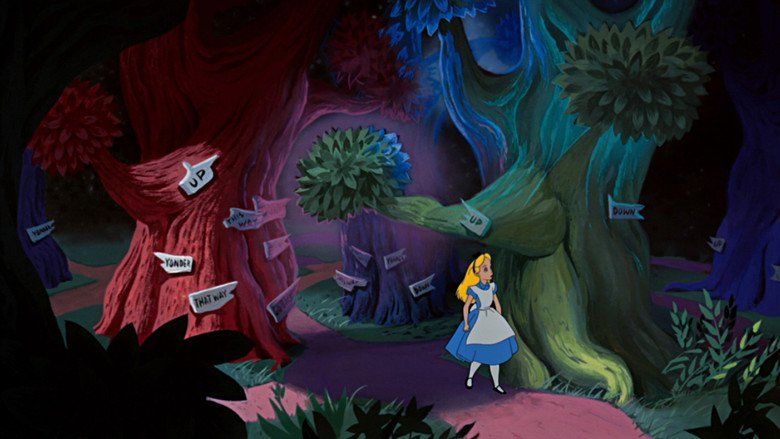
Walt Disney first attempted unsuccessfully to adapt Alice into an animated feature film during the 1930s. However, he finally revived the idea in the 1940s. The film was originally intended to be a live-action/animated film; however, Disney decided to make it an all-animated feature in 1946. The theme song of the same name has since become a jazz standard. While the film was critically panned on its initial release, the movie proved to be ahead of its Time and has since been regarded as one of Disney's greatest animated classics, notably one of the biggest cult classics in the animation medium, as well as one of the best film adaptations of Alice.
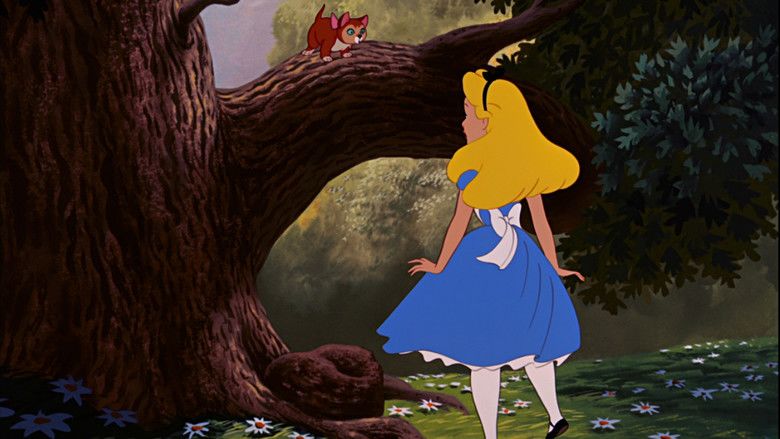
Walt disney films alice in wonderland 1951 hd trailer
Plot
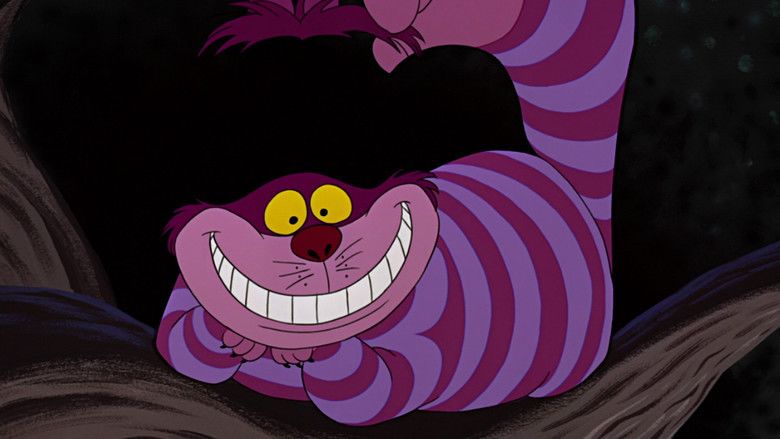
On a riverbank, Alice spots a White Rabbit in a waistcoat passing by, exclaiming that he is "late for a very important date". She gives chase, following him into a large rabbit hole. She sees him leave through a tiny door, whose talking knob advises her to shrink to an appropriate height by drinking from a bottle marked "Drink Me". She does so and floats out through the keyhole in a sea of her own tears, which she cried after eating a biscuit marked "Eat Me" caused her to grow very large. As she continues to follow the Rabbit, she meets numerous characters, including Tweedledum and Tweedledee, who recount the tale of "The Walrus and the Carpenter".

Alice tracks the Rabbit to his house; he sends her to retrieve his gloves after mistaking her for his housemaid. While searching for them, she eats another cookie marked “Eat Me” from his cookie canister and grows large again, getting stuck in the house. Thinking she is a monster, he brings the Dodo over to help him get rid of her. When the Dodo decides to burn the house down, Alice escapes by eating a carrot from the Rabbit's garden, which causes her to shrink to three inches tall, and continues following him. Along the way, she meets a garden of talking flowers who initially welcome her with a song, but then mistake her for a weed and order her to leave, followed by a Caterpillar, who becomes enraged after she tells him she is distressed at her current height, as he is the same height, and turns into a butterfly. Before leaving, he advises her to eat a piece of his mushroom to alter her size. She does so and manages to return to her original height, and continues following the Rabbit.
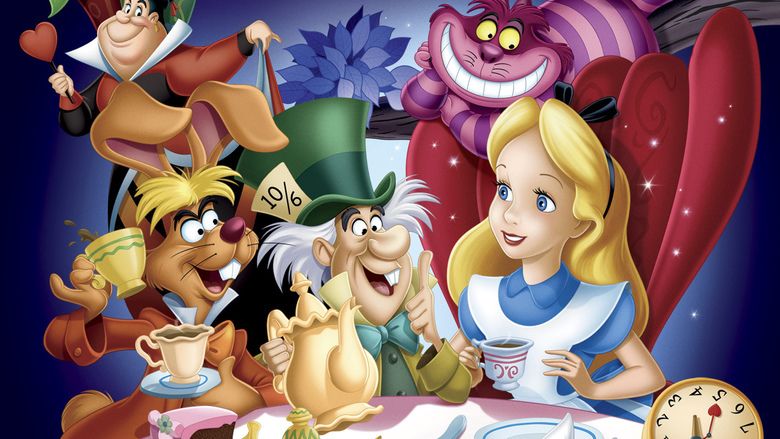
In the woods, Alice meets the Cheshire Cat, who advises her to visit the Mad Hatter or the March Hare to find out where the Rabbit is. She encounters both, along with the Dormouse, at the Hare's house having a Mad Tea Party and celebrating their "unbirthday". They celebrate her unbirthday too, but she becomes frustrated at them interrupting her every time she tries to speak. As she is above to leave, the Rabbit appears, continuing to exclaim that he is late; the Hatter examines his pocket watch and says it is "two days slow", and attempts to “fix” it by filling it with food and tea but ends up having to destroy it after it goes "mad". The Rabbit laments that his watch was an "unbirthday present", and the Hatter and Hare sing "The Unbirthday Song" to him before throwing him back into the woods. Fed up with the nonsense, Alice decides to go home, but her surroundings have completely changed and she gets lost. Fearing she is lost forever, she sits on a rock sobbing.

The Cheshire Cat reappears and advises Alice to ask the Queen of Hearts for directions home, showing her a "shortcut" to the King and tyrannical Queen's castle. The Queen orders the beheading of a trio of playing card gardeners who mistakenly planted white roses instead of red ones, and invites (or rather forces) Alice to play against her in a croquet match, in which live flamingos, card guards and hedgehogs are used as equipment. The animals and card guards rig the game in favor of the Queen. The Cat appears again and plays a trick on the Queen, causing her to fall over. She blames Alice for this, and Alice is arrested and put on trial.

At Alice's trial, the Mad Hatter, March Hare and Dormouse are called to the stand as witnesses, briefly celebrating the Queen's unbirthday and giving her a headpiece as a present, which turns into the Cat. Chaos ensues when the frightened Dormouse runs around the courtroom. As the Queen orders Alice’s execution, Alice eats the pieces of the Caterpillar's mushroom she saved and grows large again. The King and Queen order her to leave the courthouse, but she refuses and insults the Queen. As she does so, she returns to her normal size, and the Queen orders her execution. Alice flees, and the Queen, King, card guards and other characters give chase. When she reaches the small door she encountered at the beginning of the film, he shows her that she is actually already outside, asleep. She wakes up and leaves the riverbank with her sister and Dinah to go home for tea.
Directing animators
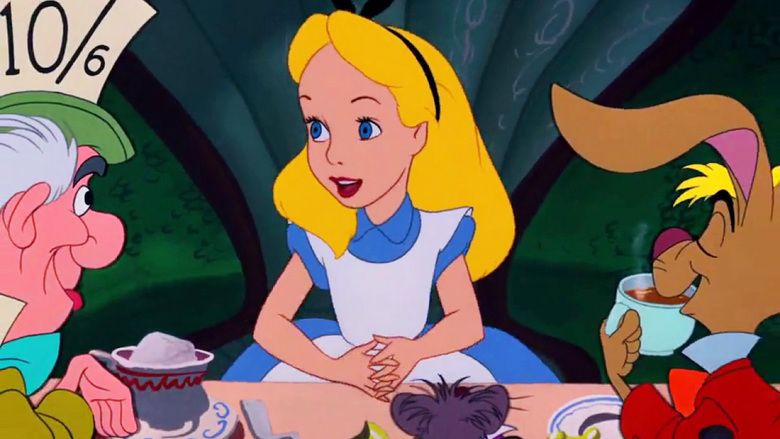
Development
The history of Walt Disney's association with Lewis Carroll's Alice books (Alice's Adventures in Wonderland and Through the Looking-Glass) stretches all the way back to his childhood. Like many children of the time he was familiar with the Alice books and had read them as a school boy.
In 1923, Disney was still a 21-year-old filmmaker trying to make a name for himself by working at the Laugh-O-Gram Studio in Kansas City, making the unsuccessful short cartoon series by the name of Newman Laugh-O-Grams. The last of Newman Laugh-O-Grams was called Alice's Wonderland, which was loosely inspired by the Alice books. The short featured a live-action girl (Virginia Davis) interacting in an animated world. Faced with business problems, however, the Laugh-O-Gram Studio went bankrupt in July 1923, and the film was never released to the general public. However, Disney left for Hollywood and used the film as a sort of pilot to show to potential distributors. Margaret J. Winkler of Winkler Pictures agreed to distribute the Alice Comedies, and Disney partnered with his older brother Roy O. Disney and re-hired Kansas City co-workers including Ub Iwerks, Rudolph Ising, Friz Freleng, Carman Maxwell and Hugh Harman to form Disney Bros. Studios (later Walt Disney Productions). The series began in 1924 before being retired in 1927.
In 1932, Disney began playing with the idea of making an animated feature film and repeatedly turned to the idea of making a feature-length animated/live-action version of Alice starring Mary Pickford, and even purchased the rights to Sir John Tenniel's illustrations (still under copyright at the time). However, these plans were eventually scrapped in favor of Snow White and the Seven Dwarfs, mainly because Disney was put off by Paramount's 1933 live-action adaptation. However, Disney did not completely abandon the idea of adapting Alice, and in 1936 made the Mickey Mouse cartoon Thru the Mirror.
In 1938, after the enormous success of Snow White, Disney revived the idea of making an Alice feature and officially registered the title Alice in Wonderland with the Motion Picture Association of America and hired storyboard artist Al Perkins and art director David S. Hall to develop the story and concept art for the film. A storyreel was complete in 1939, but Walt was not pleased as he felt that Hall's drawings resembled Tenniel's drawings too closely making them too difficult to animate and that the overall tone of Perkins' script was too grotesque and dark. Realising the amount of work needed for Alice in Wonderland, as well as the economic devastation of the World War II and the production demands of Pinocchio, Fantasia, and Bambi, Walt shelved production on Alice in Wonderland shortly after the screening.
In 1945, shortly after the war ended, Disney once again revived Alice in Wonderland and assigned British author Aldous Huxley to re-write the script. However, Walt felt that Huxley's version was too much of a literal adaptation of Carroll's book. Background artist Mary Blair submitted some concept drawings for Alice in Wonderland. Blair's paintings moved away from Tenniel's sketchy illustrations by taking a modernist stance, using bold and unreal colors. Walt liked Blair's designs, and the script was re-written to focus on comedy, music, and the whimsical side to Carroll's book.
Disney toyed with the idea of having a live-action/animated version of Alice in Wonderland (in a similar fashion to his Alice Comedies) that would star Ginger Rogers and would utilize the recently developed sodium vapor process. Lisa Davis Waltz (who would later voice Anita Radcliffe in One Hundred and One Dalmatians) and Luana Patten were also considered for the role of Alice. However, Walt soon realized that he could only do justice to the book by making an all-animated feature, and in 1946, work began on an all-animated version of Alice in Wonderland.
Writing
Through various drafts of the script, many sequences that were present in Caroll's book drifted in and out of the story. However, Walt insisted that the scenes themselves keep close to those in the novel since most of its humor is in the writing.
One omitted scene from the 1939 treatment of the film occurred outside the Duchess' manor, where The Fish Footman is giving a message to The Frog Footman to take to the Duchess saying that she is invited to play croquet with The Queen of Hearts. Alice overhears this and sneaks into the kitchen of the manor, where she finds the Duchess' Cook maniacally cooking and the Duchess nursing her baby. The cook is spraying pepper all over the room causing the Duchess and Alice to sneeze and the Baby to cry. After a quick conversation between Alice and the Duchess, the quick-tempered Cook starts throwing pots and pans at the noisy baby. Alice rescues the baby, but as she leaves the house the baby turns into a pig and runs away. The scene was scrapped for pacing reasons.
Another scene that was deleted from a later draft occurred in Tulgey Wood, where Alice encountered what appeared to be a sinister-looking Jabberwock hiding in the dark, before revealing himself as a comical looking dragon-like beast with bells and factory whistles on his head. A song, "Beware the Jabberwock", was also written. However, the scene was scrapped in favor of The Walrus and the Carpenter poem. Out of a desire to keep the Jabberwocky poem in the film, it was made to replace an original song for the Cheshire Cat, "I'm Odd".
Another deleted scene in Tulgey Wood shows Alice consulting with The White Knight, who was meant to be somewhat of a caricature of Walt Disney. Although Walt liked the scene, he felt it was better if Alice learned her lesson by herself, hence the song "Very Good Advice".
Other characters, such as The Mock Turtle and the Gryphon were discarded for pacing reasons.
Music
In an effort to retain some of Carroll's imaginative verses and poems, Disney commissioned top songwriters to compose songs built around them for use in the film. A record number of potential songs were written for the film, based on Carroll's verses—over 30—and many of them found a way into the film, if only for a few brief moments. Alice in Wonderland would boast the greatest number of songs included in any Disney film, but because some of them last for mere seconds (like "How Do You Do and Shake Hands", "We'll Smoke the Monster Out", "'Twas Brillig", "The Caucus Race", and others), this fact is frequently overlooked. The original song that Alice was to sing in the beginning was titled "Beyond the Laughing Sky". The song, like so many other dropped songs, was not used by the producers. However, the composition was kept and the lyrics were changed. It later became the title song for Peter Pan (which was in production at the same time), "The Second Star to the Right".
The title song, composed by Sammy Fain, has become a jazz standard, first adopted by jazz pianist Dave Brubeck; featured first in 1952, then on his 1957 Columbia album Dave Digs Disney.
Izumi Yukimura sang her own theme song for the Japanese release of the film.
The song, "In a World of My Own," is included on the orange disc of Classic Disney: 60 Years of Musical Magic.
Release and reception
At the time, these creative decisions were met with great criticism from Carroll fans, as well as from British film and literary critics who accused Disney of "Americanizing" a great work of English literature. Disney was not surprised by the critical reception to Alice in Wonderland – his version of Alice was intended for large family audiences, not literary critics – but despite all the long years of thought and effort, the film met with a lukewarm response at the box office and was a sharp disappointment in its initial release, earning an estimated $2.4 million at the US box office in 1951.
Though not an outright disaster, the film was never re-released theatrically in Disney's lifetime, airing instead every so often on network television. In fact, Alice in Wonderland aired as the second episode of Walt Disney's Disneyland TV series on ABC in 1954, in a severely edited version cut down to less than an hour. In The Disney Films, Leonard Maltin relates animator Ward Kimball felt the film failed because "it suffered from too many cooks – directors. Here was a case of five directors each trying to top the other guy and make his sequence the biggest and craziest in the show. This had a self-canceling effect on the final product." Walt Disney himself felt that the film failed because there was no "warmth" in Alice's character.
Almost two decades after its original release, after the North American success of George Dunning's animated film Yellow Submarine (1968), Disney's version of Alice in Wonderland suddenly found itself in vogue with the times. In fact, because of Mary Blair's art direction and the long-standing association of Carroll's Alice in Wonderland with the drug culture, the feature was re-discovered as something of a "head film" (along with Fantasia and The Three Caballeros) among the college-aged and was shown in various college towns across the country. Disney resisted this association, and even withdrew prints of the film from universities, but then, in 1974, Disney gave Alice in Wonderland its first theatrical re-release ever, and the company even promoted it as a film in tune with the "psychedelic" times (mostly from the hit song "White Rabbit" performed by Jefferson Airplane). This re-release was so successful it warranted a subsequent re-release in 1981. Its first UK re-release was on July 26, 1979.
Later, with the advent of the home video market, Disney chose to make Alice in Wonderland one of the first titles available for the rental market on VHS and Beta and for retail sale on RCA's short-lived CED Videodisc format. The film was released on October 15, 1981 on VHS, CED Videodisc, and Betamax and May 28, 1986 on VHS, Betamax, and Laserdisc in the Walt Disney Classics, (though it was mastered for tape in 1985), staying in general release ever since, with a 40th Anniversary video release in 1991 (this and the 1986 video release were in Disney's Classics Collection), followed by an October 28, 1994 October 14, 1997 VHS and Laserdisc release as a part of the Walt Disney Masterpiece Collection.VHS and Laserdisc release as a part of the Walt Disney Masterpiece Collection. It was released on Region 1 DVD on July 4, 2000 (under the Gold Classic Collection DVD series). A fully restored two-disc "Masterpiece Edition" was released on January 27, 2004, including the full hour-long episode of the Disney television show with Kathryn Beaumont, Edgar Bergen, Charlie McCarthy and Mortimer Snerd, Bobby Driscoll and others that promoted the film, computer games, deleted scenes, songs and related materials, which went back on moratorium in January 2009. Disney released a 2-disc special "Un-Anniversary" edition DVD on March 30, 2010 in order to promote the then-new Tim Burton film. The movie was released in a Blu-ray/DVD combo on February 1, 2011 to celebrate its 60th anniversary featuring a new HD restoration of the movie and many released bonus features. Disney re-released the film on Blu-ray and DVD on April 26, 2016 to celebrate the film's 65th anniversary.
On the film aggregator website, Rotten Tomatoes, the overall rating of the film is a "fresh" 79% from 28 critical reviews with an average rating of 6.4/10. Its consensus states that "A good introduction to Lewis Carroll's classic, Alice in Wonderland boasts some of the Disney canon's most surreal and twisted images."
The film was nominated for an Academy Award for Best Scoring of a Musical Picture, but lost to An American in Paris.
Soundtrack
The film soundtrack was first released on LP record on July 28, 1951. The soundtrack was re-released on Audio CD by Walt Disney Records on February 3, 1998.; Songs in the film
Audio CD track listing
- "Main Title (Alice in Wonderland)"
- "Pay Attention/In a World of My Own"
- "I'm Late"
- "Curiosity Leads to Trouble/Simply Impassable"
- "The Sailor's Hornpipe/The Caucus Race"
- "We're Not Waxworks"
- "How D'Ye Do and Shake Hands/Curious?"
- "The Walrus and the Carpenter"
- "Old Father William"
- "Mary Ann!/A Lizard with a Ladder/We'll Smoke the Blighter Out"
- "The Garden/All in the Golden Afternoon"
- "What Genus Are You?"
- "A-E-I-O-U (Ray the Caterpillar Song/Who R U?)"
- "A Serpent!"
- "Alone Again/'Twas Brillig/Lose Something"
- "The Mad Tea Party/The Unbirthday Song"
- "The Tulgey Wood" (Music incomplete on audio CD)
- "Very Good Advice"
- "Whom Did You Expect"
- "Painting the Roses Red/March of the Cards"
- "Marie the Queen of Hearts/Who's Been Painting My Roses Red?"
- "A Little Girl/Let the Game Begin/I Warn You Child"
- "The Trial/The Unbirthday Song (Reprise)/Rule 42/Off with Her Head/The Caucus Race"
Stage version
Alice in Wonderland has been condensed into a one act stage version entitled, Alice in Wonderland, Jr.. The stage version is solely meant for middle and high school productions and includes the majority of the film's songs and others including Song of the South's "Zip-a-Dee-Doo-Dah", two new reprises of "I'm Late!", and three new numbers entitled "Ocean of Tears", "Simon Says", and "Who Are You?" respectively. This 60–80 minute version is licensed by Music Theatre International in the Broadway, Jr. Collection along with other Disney Theatrical shows such as Disney's Aladdin, Jr., Disney's Mulan, Jr., Beauty and the Beast, Disney's High School Musical: On Stage!, Elton John and Tim Rice's Aida, and many more.
References in other Disney films
Theme parks
Costumed versions of Alice, The Mad Hatter, The White Rabbit, The Queen of Hearts, Tweedledum, and Tweedledee make regular appearances at the Disney theme parks and resorts, and other characters from the film (including the Walrus and the March Hare) have featured in the theme parks. More famously, all five Disneyland-style theme parks feature Mad Tea Party, a teacups ride based on Disney's adaptation of Alice in Wonderland.
Alice in Wonderland is also frequently featured in many parades and shows in the Disney Theme Parks, including The Main Street Electrical Parade, SpectroMagic, Fantasmic!, Dreamlights, The Move It! Shake It! Celebrate It! Street Party and Walt Disney's Parade of Dreams. Disneyland contains a dark ride based on the film in addition to the teacups, and Disneyland Paris also contains a hedge maze called Alice's Curious Labyrinth, which takes its inspiration from the film. The now-defunct Mickey Mouse Revue, shown at Walt Disney World and later at Tokyo Disneyland, contained characters and scenes from the film.
The 2010 Tim Burton adaptation had much less of an effect on the park, only inspiring Mad T Party, a nighttime event at Disney California Adventure.
Video games
In Disney's Villains' Revenge, the Queen of Hearts is one of the villains who tries to turn the ending to her story to where she finally cuts off Alice's head. Mickey Mousecapade features various characters from the film. The Japanese version, in fact, is based very heavily on the film, with almost every reference in the game coming from the film.
A video game version of the film was released on Game Boy Color by Nintendo of America on October 4, 2000 in North America. Additionally, in the video games Kingdom Hearts and Kingdom Hearts: Chain of Memories, Wonderland is a playable world. Alice is also a major character in the overall plot of the first game due to her role as one of seven "Princesses of Heart". Other characters from the movie that appear include the Queen of Hearts, the Cheshire Cat, the White Rabbit, the Doorknob, the Caterpillar (V Cast only), and the Deck of Cards. The Mad Hatter and the March Hare appear in portrait form as well. All except the Doorknob also appear in Chain of Memories, albeit in the form of illusions made from the main character's memory. While the world is absent in Kingdom Hearts II, it returns in Kingdom Hearts 358/2 Days and Kingdom Hearts coded, the latter featuring a digitized version of the world originating from data in Jiminy Cricket's royal journal.
In Toy Story 3: The Video Game, the Mad Hatter's hat is one of the hats you can have the townsfolk wear. In Kinect Disneyland Adventures, Alice, Mad Hatter, White Rabbit, and the Queen of Hearts make appearances.
In Disney Infinity there are power discs based on Alice in Wonderland.
Several characters of the movie make appearances throughout the Epic Mickey-games. For example, the cards are seen throughout Mickeyjunk Mountain in the original Epic Mickey, Alice appears as a statue carrying a projector screen in Epic Mickey 2 and Alice, the Mad Hatter, the Cheshire Cat and the Queen of Hearts appear as unlockable characters in Epic Mickey: Power of Illusion.
References
Alice in Wonderland (1951 film) WikipediaAlice in Wonderland (1951 film) IMDbAlice in Wonderland (1951 film) Rotten TomatoesAlice in Wonderland (1951 film) themoviedb.org
